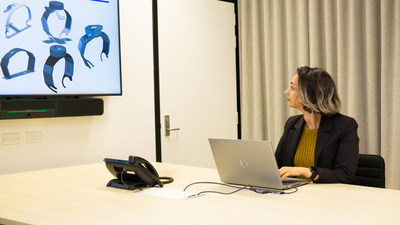Could this game wave goodbye to nerve pain?

A recent trial of an interactive game that has shown promise as a treatment for nerve pain could offer hope for a new generation of drug-free treatments. The ‘PainWaive’ technology, developed by UNSW Sydney researchers, offers a potential in-home, non-invasive alternative to opioids — teaching users how to regulate abnormal brain activity linked to chronic nerve pain. UNSW Sydney NeuroRecovery Research Hub researchers Professor Sylvia Gustin and Dr Negin Hesam-Shariati led the recent trial, which, they say, delivered promising results.
In the PainWaive study, which builds on Gustin’s research into changes in the brain’s thalamus (a central relay hub in the brain) associated with nerve (neuropathic) pain, hundreds of measures across participants’ pain and related issues like pain interference before, during and after four weeks of interactive game play were compared. Participants’ brain activity was tracked via electroencephalogram (EEG) headsets — with the game app responding in real time to shifts in brainwave patterns.
“The brainwaves of people with neuropathic pain show a distinct pattern: more slow theta waves, fewer alpha waves, and more fast, high beta waves,” Gustin explained. “We believe these changes interfere with how the thalamus talks to other parts of the brain, especially the sensory motor cortex, which registers pain.
“I wondered, can we develop a treatment that directly targets and normalises these abnormal waves?” PainWaive was developed in response to this challenge.
For the initial trial, four participants took part, receiving a kit with a headset and a tablet preloaded with the game app, which includes directions for its use. Tips for different mental strategies — like relaxing or focusing on happy memories, to help bring their brain activity into a more ‘normal’ state — were also given, with user data uploaded to the research team for remote monitoring. “After just a couple of Zoom sessions, participants were able to run the treatment entirely on their own,” Hesam-Shariati said.
“Participants felt empowered to manage their pain in their own environment,” Hesam-Shariati added. “That’s a huge part of what makes this special.”
It was found that significant reductions in pain, particularly nearing the end of the treatment, was shown in three out of the four participants and that, overall, the pain relief achieved by the three was comparable to or greater than that offered by opioids. “Restrictions in the study’s size, design and duration limit our ability to generalise the findings or rule out placebo effects,” Hesam-Shariati noted. “But the results we’ve seen are exciting and give us confidence to move to the next stage and our larger trial.”

Hesam-Shariati also explained that the team had initially planned to use existing commercial EEG systems; however, these either didn’t meet the quality needed to deliver the project or were too expensive — so they developed their own. “Everything except the open-source EEG board was built in-house,” Hesam-Shariati said. “And soon, even that will be replaced by a custom-designed board.”
Via 3D printing, the team has been able to cut the cost of each headset to around $300 — a fraction of the $1000 to $20,000 price tags of existing systems, Gustin said.
“We’ve worked closely with patients to ensure the headset is lightweight, comfortable and user-friendly,” Gustin said, with the headset using a saline-based wet electrode system to improve signal quality and target the sensorimotor cortex. “Owning the technology offers us the potential to one day offer PainWaive as a truly affordable, accessible solution for at-home pain management, especially for those with limited access to traditional treatments.”
**************************************************
Results of the trial were published this year in The Journal of Pain (doi.org/10.1016/j.jpain.2025.105394). Two further trials are on the horizon. The first, ‘Spinal Pain Trial’, will investigate its potential to reduce chronic spinal pain, while the second, ‘StoPain Trial’, will explore its use in treating chronic neuropathic pain in people with a spinal cord injury.
**************************************************
Could this tailored heart pump transform care for half of heart failure patients?
Half of the 64 million people living with heart failure have no access to heart pump treatments....
Breastfeeding challenges healthcare professionals should be prepared to address
A neonatal nurse and lactation consultant sets out what she sees as the most common breastfeeding...
Framework seeks to cut medicine errors at transitions of care
The first coordinated, hospital-based approach to medication management at transitions of care...




![[New Zealand] Transform from Security Awareness to a Security Culture: A Vital Shift for SMB Healthcare — Webinar](https://d1v1e13ebw3o15.cloudfront.net/data/89856/wfmedia_thumb/..jpg)
![[Australia] Transform from Security Awareness to a Security Culture: A Vital Shift for SMB Healthcare — Webinar](https://d1v1e13ebw3o15.cloudfront.net/data/89855/wfmedia_thumb/..jpg)




